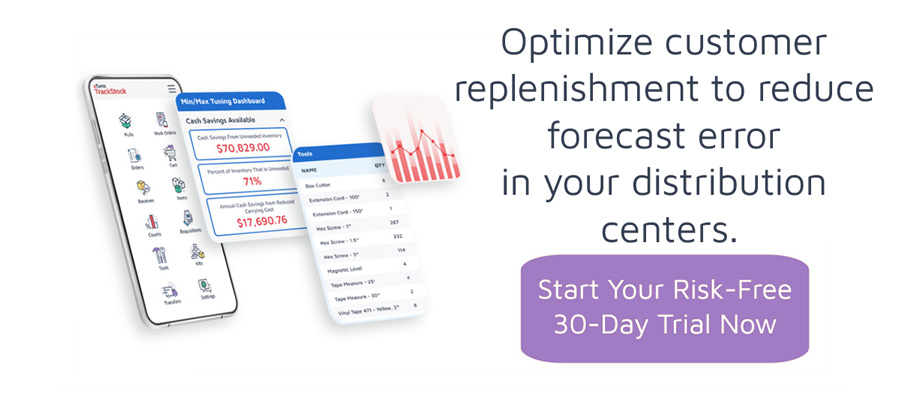How to Reduce Forecast Error: Focus on Usage Data, Not Sales History

To forecast demand and plan inventory needs in their own distribution centers and at customer locations, distribution companies tend to depend on historical sales data, as well as a usually arbitrary sales goal for the year.
For example, if they want to grow 5% in 2023, they increase stock of the items sold over the past 12 months by the same amount based on their aggregated sales history. They may add in seasonality, but in general, most distributors’ forecasts follow this formula. They may also add in salespeople’s forecasts for their own territories based on expected purchases. Distributors typically assume that the same demand for individual items will occur at the same time in the same quantity each year.
Most know there are flaws in this method. But everyone is working to get as close as possible to the stock levels required to best serve their customers. Not surprisingly, distributors are always looking for more ways to increase accuracy and reduce forecast error.
What is forecast error?
At its most basic, forecast error is the difference between the forecast demand and the actual demand. A lot of calculations go into forecast error, but the bottom line is that the greater the difference between actual demand and forecast demand, the greater the impact on a distributor’s bottom line.
As forecast error goes up, the risks go up:
- Overstocking inventory in a distribution center or a customer’s location, significantly increasing carrying costs
- Stockouts of critical items, increasing the risk a customer will go elsewhere to fill those needs
- Increased lead times for new items with shorter sales histories
Why is forecast accuracy important?
Forecast accuracy matters. It drives decisions on what to buy and when, as well as what to stock and where. It could also drive decisions around hiring personnel and where you allocate your most expensive resource. It can mean the difference between meeting your customers’ needs, or service breaking down when customers need it most.
What causes forecast error to go up? Here are a few factors:
-
Distributor-customer inventory-level agreements.
Many distributors have agreements with customers that require them to have a certain level of inventory – no matter what. It may be two to even 15 times more than what they need, but because they agreed to do it, they must stock it contractually. That will skew forecasts. And if distributors aren’t compensated in some way for holding that inventory, it will cost 25% to 55% of the inventory cost annually to carry it.
-
Safety stock for rarely used items.
Some customers need certain items in stock, even though they only use them once or twice a year. But if they don’t have them in stock when they need them, it could cause a production line to go down or a project to stall temporarily. The problem is that these items could go obsolete before the customer even uses them. And if they are purchased for the sake of putting them on a shelf, that sales history will be reflected in any forecast. We’re not saying you shouldn’t stock these for customers; but the data needs to be considered when making purchasing decisions based on sales history.
-
Relevance of the data.
More than the quality of the data, the relevance of the data in a distributor’s inventory system has a big impact on forecast error. When a distributor lists all the items a customer purchased in the past 12 months and bases future inventory purchases on that data, they miss any shifts in the customers’ businesses. For example, an electrical contractor may be doing more lighting in a new year instead of just general construction projects. So the items that the customer is going to order will change. And that means the relevance of that customer’s sales history for forecasting loses a lot of value.
-
Sales reps keeping market or customer shifts to themselves.
Distributors tend to have siloes when it comes to data within the organization. For example, sales reps working day-in and day-out with customers probably have the intelligence that inventory managers need to reduce forecast errors. But that front-line data does not usually make it to the people that need it. Sales reps also frequently default to overstocking a customer’s location because they are afraid the customer will go elsewhere if they don’t have what they need. (They are usually compensated based on volume, as well, so there is little incentive to pare down customer inventory.) The just-in-case mentality rules. Very few reps in any industry will make the effort to tell management what the customer is actually using vs. what’s just collecting dust on the shelf.
Distributors can reduce inventory significantly when they base purchasing off usage, and not just past sales.
How to reduce forecast error
The simplest way to reduce forecast error is to base demand planning on actual usage data vs. historical sales. The difference: Usage reflects actual consumption of an item. In other words, just because a product was sold to a customer doesn’t mean that product was used. Customers are notoriously overstocked. Distributors can reduce inventory significantly when they base purchasing off usage, and not just past sales. When you parse the data, some distributors have found they have up to 80% more inventory than they need.
With the eTurns TrackStock Automated Replenishment Apps, distributors track and replenish inventory for customers at the point-of-use. Distributors can leverage this usage data to optimize their distribution centers and to consign inventory at customer sites, reduce carrying costs and improve customer service.
The eTurns TrackStock Apps provide you with:
- Which items your customers are going to order
- The quantity they will order of those items
- The precise date those items will be ordered
because it can calculate these valuable data points from the point-of-use:
- Quantity on Hand (QOH)
- Minimum Stock Levels (Min)
- Maximum Stock Levels (Max)
- Average Daily Usage
It’s simple, but powerful. When you can be certain of your near-term demand planning, you reduce forecast error. If usage is constant or fairly constant for an item, such as a customer’s bread and butter (like switches and wall plates for an electrical contractor), you can be confident that future purchasing patterns will follow past usage.
The key is a shorter time frame. Using a full year of generic aggregated data presents too many opportunities for error. eTurns TrackStock looks at 30-45 days of usage data – continually updated, in real time – that can then be extrapolated for longer periods. Our Precise Demand Planning solution excludes data from items that aren’t used regularly, and it incorporates item data that comes into the system that is new – such as a new product line that a customer suddenly wants but could not be forecast based on historical sales.
Distributors have significant opportunities to tighten their relationships with their customers this year, but they need tools that can support these value-added services without straining cashflow or cutting into their bottom lines. That means they need to reduce forecast error to ensure they are stocking what they need, when they need it. Automated replenishment through the eTurns TrackStock Optimize App gives them a powerful Min/Max Tuning Dashboard that uses a customer’s actual usage data to optimize inventory and save cash, not only in the first year, but on an ongoing basis.
That saves the distributor – and the customer – money.
Ready To Try Out eTurns TrackStock?
Start your free trial and see how easy it is to use eTurns to reduce forecast errors in your distribution centers by accurately replenishing your customers with our VMI/CMI app.





